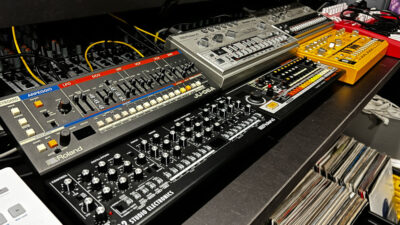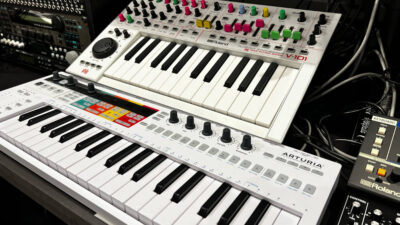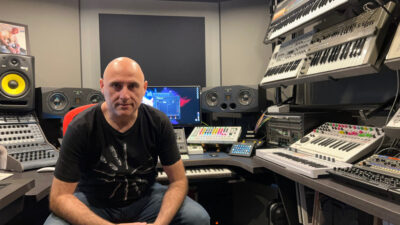Producer Pad: Vince Watson’s “Mothership” Lands in Amsterdam
Embark on the sweet spot that is Vince Watson’s studio – you’ll want to spend some time aboard.
Part synth heaven, part spacecraft, this prolific Amsterdam electronic artist’s pad is aptly named The Mothership. It’s the level-up audio home for Watson, a Scotland-born “producer’s producer” going strong for two-plus decades. Launched in 2020, The Mothership gives Watson the perfect place to create.
His latest release is DnA [re]Sequenced, a remix album of Watson’s 2019 smash DnA. It features remixes from an all-star roster including Carl Craig, Jon Dixon, Steve Rachmad, Claude Young, John Beltran, Stephan Lopkin, Stephen Brown, and Shawn Rudiman.
DnA [re]Sequenced is instantly addictive, starting with the gripping groove of “Holographic (Carl Craig’s Ride or Die Anthem)” and never letting up. The jazzy “[re]Evolution (Jon Dixon remix)” rides on tight lines, and there’s motivating tension in “Second Wave (Steve Rachmad Remix).”Over his career, Watson has worked with many of the top names in techno and Detroit Techno. Collaborators include Laurent Garnier, Joe Claussell, Richie Hawtin, Sven Vath, Carl Craig, Osunlade, Steve Bug, and Josh Wink.
Interestingly, it was the act of saying “Goodbye” to Detroit Techno that led Watson to re-embrace the genre all over again. The producer/artist/DJ made the decision after the release of 2019’s delicious DnA, then saw the album elicit a huge response. That led to his vision of a remix album, recruiting a wish-list of artists hailing from Scotland, Amsterdam, or Detroit.
In this Producer’s Pad, Watson reveals The Mothership. We’ll start in its super ergonomic nucleus, then branch out to his mouth-watering digital and analog synths. A producer who’s travelled the journey of hardware into software and back again, he explains what creative tools he keeps and the new ones he takes in.
Don’t miss this Scottish synth master’s invaluable synth arranging and mixing tricks. And note his people skills pointers, which are equally important.
Watson is also a University Degree Lecturer at Conservatorium van Amsterdam: In 2017, he helped start the AEMA (Amsterdam Electronic Music Academy). That’s where he teaches courses like “Stylelabs,” which instructs about different style techniques and content, and “The Art of Remixing” for detailed remixing and analysis. In the DJ courses, Watson and his colleagues not only teach traditional mixing, but also hybrid setups and technically advanced live scenarios.
Memorable techno, pro tips on how to produce electronic music, and now The Mothership itself – we’ll gladly take in all Vince has to share.
Producer Pad
Facility Name: The Mothership
Location : Amsterdam, Netherlands
Date of Birth: June 2020
Facility Focus: Custom built Garden Studio – Mostly focusing on my own music production – but also available to AEMA alumni for hire starting in 2022.
Clients: Vince Watson/Quart
For Example:

Recent Release: Making the original DnA concept was about saying “Goodbye.” I felt like I had made the [techno] genre for so long that I wanted to move in a different direction, so to go out with a bang with an 18-track album felt like the right thing to do.
Little did I know that not only did I become re-inspired in the process, but it ended up selling extremely well, so made me realize I was never going to get away from it! From the very beginning though I always knew I would do a remix album to try and reflect the sources of my inspiration and bring the story full circle by asking artists I knew and loved to come on board – artists from Scotland (where I’m from), artists from Detroit (where I’m inspired from) and artists from Amsterdam (where I am now).
DnA [re]Sequenced is just the first part of the concept. There will be more next year.
System Highlights: I think like most I’ve been through the typical journey of hardware into software and back again to some degree, but I was definitely a late developer. I was so fast and efficient on my trusted old MPC and Ensoniq Sequencer that it took me until Ableton v4 before I saw the light.
Then, slowly but surely, I committed a cardinal sin of selling a lot of hardware along the way. However, some will never leave and are still in use today. My Roland 101, 909, 808, 303 and Juno-106 are less than two feet away from me at all times.
Around me I also have my custom painted Roland TR-8S (now known to me as the VR9) with all my mastered drum sounds from all my releases, as well as the Akai Force sampler/sequencer and Eventide H9 Max effects pedal. I like having such powerful instruments at my fingertips over and above the software in front of me.
In the new studio, my focus in front of me is my Softube Console 1 and Console Fader rack. I’m using it extensively now that VST3 has full integration with Ableton with the Softube Console 1 SSL XL 9000 K plugin. It sounds amazing.
Software-wise I’m a Spitfire Audio freak so use them a lot for orchestral stuff. For keys I made the switch from my forever trusted Synthogy Ivory II to Omnisphere Keyscape. Having used Omnisphere for many years, I’m not sure why it took me so long but it’s an incredible library.
Synth Head: I tend to buy a lot of gear, and after playing for a while send it back or sell it not long after. I’m quite picky with the stuff that gets to stay on the shelves permanently – it has to really have something I can’t already do elsewhere or simply sound like something I love.
In this room I have enough space for eight five-octave synths, but being a drum machine freak makes that more like space for four. The rest come out of storage when I need something from them.
I’m absolutely loving the Virus Ti2 again. I kind of stopped using it as my last setup with it, the software implementation was a nightmare, but it’s working fine now and I keep being reminded how good a digital synth it is. The Prophet Rev2-08 is also staying for sure.
My custom Rolands were a nice project to do. They took a while to get the design right and it wasn’t until Roland invited me to the Artist Centre in Tokyo, that I was finally able to get the official knobs in the colors I needed, as they were never on sale. The Roland System-1 (now known to me as the V101), is a standard machine which I use only for the Roland SH-2 PLUG-OUT as it’s such a low-end monster.
Synth TRICKS: Getting maximum control of your spectrum with every sound is so important. I hear/see too many students or young producers having for example big pad sounds in their tracks with lots of low end that doesn’t need to be there.
Or a bassline that has great mids but weak low end and they settle for that as their bassline, without considering layering. Layer Layer Layer.
The building is on fire, you only have time to grab ONE thing to save, what is it? The birthday card that my daughter drew for me when she was three! Everything hardware-wise can be found again, granted with some heavy costs but do-able.…and all software and data is backed up three times anyway.
How You Can Make it to Your Own Producer Pad: Never, ever stop believing in yourself. Never, ever divert from your instincts and be absolutely true to yourself.
Finally, be nice. The music scene is a rollercoaster full of very high ups and extremely low downs…When you’re nice to people on the way up, they remember this when you’re on the way down, making your route back up again a bit easier. There are enough egos to fill the space already.

— David Weiss is an Editor for SonicScoop.com, and has been covering pro audio developments for over 20 years. He is also the co-author of the music industry’s leading textbook on synch licensing, “Music Supervision, 2nd Edition: The Complete Guide to Selecting Music for Movies, TV, Games & New Media.” Email: david@sonicscoop.com
Please note: When you buy products through links on this page, we may earn an affiliate commission.












